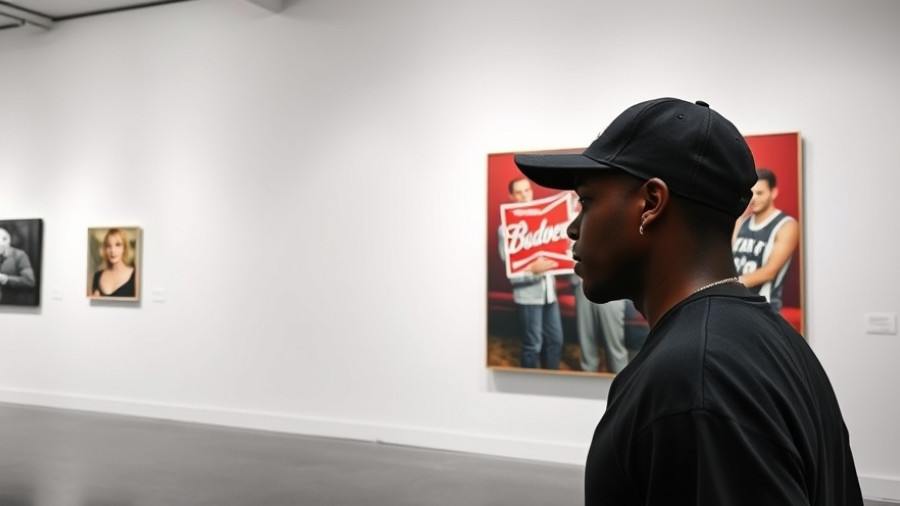
Exploring the Depth of Identity in Art
The recent exhibition "Outside," hosted at Hawkins HQ, marks a significant return for two esteemed Atlanta artists, Taylor Simmons and Gerald Lovell, as they reconnect with their roots to explore pressing themes of identity, memory, and community. Curated by Rosa Duffy, this exhibition offers a visual narrative that confronts the complexities of Black representation in contemporary art. However, amidst the vibrant works presented, one might ponder if reflections alone suffice for advocacy and understanding in the art world.
The Artistic Landscape: A Homecoming Worth Analyzing
Debuting at the end of September, "Outside" has been described as an artistic homecoming, not just for Simmons and Lovell but for the broader narrative of Black artists in Atlanta—a city celebrated as a cultural haven for Black excellence. This exhibition juxtaposes their works against that of Jurell Cayetano, delving into shared experiences that resonate deeply with local and national audiences. The concept of home looms large over their artistic discourse, posing the question: What does it mean to claim one’s identity and narratives in a society working to erase them?
Understanding Resistance Through Art
The exhibition text introduces the notion of resistance against being pushed underground—a powerful statement reflecting the lived experience of Black individuals. But what does this resistance truly entail? Is it a reaction against the White gaze, or does it serve a more profound purpose of self-assertion? Duffy’s curatorial framing leaves viewers with lingering queries about the motivations behind the artwork. The themes explored by Simmons, Lovell, and Cayetano urge us to consider whom the works are ultimately serving.
Figuration: A Historical Tool for Liberation
The undercurrent of figuration as a mode for expressing Black identity is not lost on the viewer. Historically, figuration has served as a counterpoint to reductive stereotypes, illustrating individuality and complexity long ignored in mainstream art narratives. During the Harlem Renaissance, artists employed figuration to combat derogatory portrayals endemic to their realities. Today, the same principles apply as contemporary artists like Simmons and Lovell recycle tradition to push boundaries—and ask new questions about identity and visibility. But is it enough to simply echo the past without offering innovative ways to approach it?
The Dichotomy of Visibility: A Double-Edged Sword
In discussing the exhibited works, it’s essential to confront the dual nature of visibility. Édouard Glissant’s concept of the “right to opacity” presents an intriguing tension against the desire for acknowledgment and visibility. While artists often wish to assert their presence and narrative within public spaces, it is pivotal to question whether such visibility inherently equates to liberation. The pieces that feature familiar stereotypes—like Lovell’s depiction of a Black hand grasping a bottle of Hennessy—evoke the complicated dynamics of representation, prompting viewers to ask: Are these depictions flipping the narrative or performatively adhering to it?
Contemporary Conversations: Bridging Past and Future
Within the context of "Outside," the idea of conversation reverberates across various mediums. This exhibition offers a critical tapestry woven from past and present narratives. Artists today must grapple with how historical injustices inform current perspectives. As we celebrate Black artistic achievement, we must also scrutinize the narratives we consume and support. Exhibitions like "Outside" seek to contribute to the ongoing dialogue surrounding Blackness and representation but must constantly evolve to avoid stagnation.
Empowerment and Agency Through Artistic Expression
One of the strengths of this exhibition lies in its commitment to empowering Black artists. The works of Simmons, Lovell, and Cayetano showcase an agency that is often denied in traditional artistic spaces. Their creations declare residence and presence in a domain where Black artists have historically been relegated to secondary roles. Yet, there's a palpable tension in wielding this power; one must wonder if mere participation is enough, or if there exists a need for deeper structural changes within the gallery frameworks that showcase their works.
Conclusion: Questions of Visibility and Meaning
As the exhibition "Outside" navigates the weighty themes of identity, visibility, and representation, it ultimately beckons viewers to reflect deeply on their own roles and biases. This moment calls for more than passive observation; it implores us to engage actively and challenge our perspectives about art and the narratives it presents. In the face of ongoing societal struggles against erasure, understanding the intricacies of representation through the lens of art provides a timely narrative that resonates far beyond the gallery walls.
Now, more than ever, we are invited to participate in this essential dialogue about identity and representation—both in the art community and beyond. Explore your own connections to these themes, and consider how you might engage with the conversations raised by artists in your local community.
 Add Row
Add Row  Add
Add 




Write A Comment